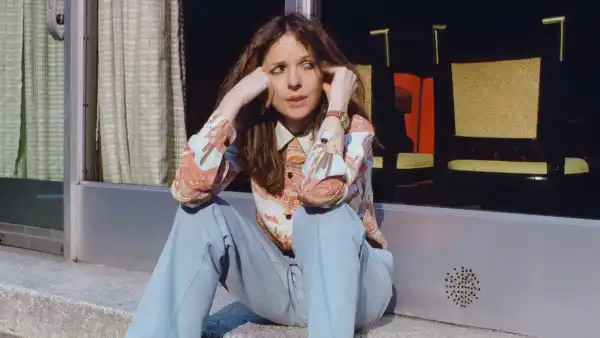
Save this storySave this storySave this storySave this story
In his audacious, ingenious, touching, and frequently very amusing volume “The New Biographical Dictionary of Film,” the critic David Thomson explores how certain stars emanate a sort of supernatural virtue, which, one can assume, reflects a specific sort of light onto viewers. Not the exquisite, gloomy fate that Montgomery Clift conveyed on camera, for example, or the uneasy, playful acuity that Jeffrey Wright and Regina Hall contribute to their craft, but something as comforting as sunlight and equally captivating. And while Diane Keaton, who passed away on October 11th, at the age of seventy-nine, will be celebrated for the allure of her method toward humor—How did I, a perfectly pleasant woman from Santa Ana, arrive here? Why, and how, am I doing this?—it’s the inherent righteousness that marks all her productions, the light that pierces through the haze of uncertainty, that will endure with us most emphatically. We adored her for her hesitancy about acting, how she yearned to be recognized even as she evaded it, obscuring her face under the shadow of a hat, or behind shaded lenses, or in the embrace of one of her cinematic partners. It was the subtlety of that wavering that maintained our attention, and sometimes kept us anticipating, because we’d all been present when it concerned affection or authority: Is this mine to possess and to cherish? Or should I return it? Keaton wasn’t a covetous star, eager for recognition, like Bette Davis, or attractive and silent, like Isabelle Adjani, or as firmly grounded in the world as Diana Sands. She distanced herself from her own renown, even as she desired visibility, and so successful was Keaton’s sidestepping of her “I” that we hardly noticed that her profession persisted as long as those of her most triumphant male peers—Pacino, De Niro, and so forth—something extremely unusual for a female luminary in Hollywood.
Keaton’s hesitation manifests in numerous of her parts, as well. So frequently, onscreen, we can observe the process of deliberation that her characters undergo; and, when they pause their indecision and examine it closely, the outcome is unforgettable. In Woody Allen’s “Love and Death” (1975), which was influenced by Russian literature—Tolstoy, Dostoyevsky, that crew—Keaton embodies Sonja, a capricious woman desired by a multitude of men with drooping mustaches, in the Napoleonic era. Sonja is unsatisfied. What is existence? she ponders. Then again, What time is our reservation? Standing in an attic, she converses with her cousin, Boris (Allen), who has distinguished himself in their town as both a wimp and a philosopher, concerning the essence of being:
SONJA: I feel as though my life would be squandered if I didn’t have a deep love for a man whose intelligence I esteemed, whose spirituality matched mine, and who possessed the same ardent yearning for sensual passion that drives me crazy.
BORIS: You’re an incredibly complicated woman.
SONJA: I guess you could say I’m half saint, half harlot.
BORIS: Here’s hoping I get the half that eats.
A segment of what renders Keaton and Allen’s partnerships so exceptional—they cooperated on eight films—is that Keaton never affords us the impression that she genuinely perceives or grasps what Allen is articulating. Her characters flit along in expression, rarely settling on anything for an extended period. (Meryl Streep characterized Keaton’s Annie Hall as a hummingbird whose thoughts dash here and there.) You recall Keaton’s Mary, in “Manhattan” (1979), visiting Isaac (Allen) after his married closest friend, Yale (Michael Murphy), has ended things with her. Isaac dwells in a boisterous New York apartment, and, to soothe herself, Mary resolves to consume a Valium. Isaac, apologetically, provides her a glass of water that contains rust from the pipes. Mary is carrying on about Yale, sobbing, and then, amidst the drama, she halts and remarks about the water, “God, this is brown, isn’t it?” Keaton could pivot in an instant—from despair to objective observation of the circumstance and her position within it. Which was where? In the lucidity of her equivocation. She might shatter your heart repeatedly, but hers was already slightly damaged.
Keaton’s performances manifest a kind of ethical standard, distinctly American: even Louise Bryant, the at times unconventional journalist Keaton portrayed in Warren Beatty’s “Reds” (1981), a character she stated she did not appreciate, grapples considerably with the query of right and wrong, and how to subsist—if you could term it existing—within the constraints of a gender-based Puritanism. That monumental struggle—how to exist—also explains Theresa Dunn’s distress in “Looking for Mr. Goodbar” (1977), helmed by Richard Brooks. A Catholic woman who survived polio, Keaton’s Theresa is, when we encounter her, training to be a teacher for the hearing impaired and engaged in an affair with a married professor. When the professor eventually spurns her, she recoils from him—an act of apology that her mouth cannot utter—inquiring, Why? Is it her scent that repels him? Is she too proper in bed? (It’s as though Theresa were reciting from a catalogue of “don’ts” in a women’s publication.) When he delivers a final insult, she folds inward on herself, like a child being attacked by someone she considered a companion. (“What I recall about that experience,” Keaton once communicated to me, “was how compassionate Richard Brooks was.”) Wounded and confused, Theresa pledges—silently—never to re-experience that sensation, never to be at anyone else’s mercy. And for significant portions of “Looking for Mr. Goodbar,” she embodies the male perspective, and just as self-absorbed. She can occupy her physique, which she regards as spiritually tainted, only through activity and the prospect of peril. Even Christ can’t disperse the shadows from Theresa’s intellect. (Her faith is part of the attraction for her when she approaches and seduces unknown men: she is sinning in His estimation.)
In Vanity Fair in 1987, Keaton confided in Joan Juliet Buck, “I was always quite devout as a youngster, but I encountered difficulty with Jesus prematurely because I couldn’t fathom that there was a son of God present on earth. I was primarily intrigued by religion because I aspired to go to paradise.” Yearning to be elsewhere, someone different, up in the heavens, is the hallmark of a visionary, and Keaton’s characters, like the terminally sick Bessie in “Marvin’s Room” (1996), envision joy, a joy that is less fleeting than life. Bessie’s father, Marvin, has suffered a stroke and is unable to speak, so Bessie elevates a mirror to the window to reflect sunbeams toward him and induce him to smile and perceive the warmth of the world’s core. In those instances, she’s like an older Laura from Tennessee Williams’s “The Glass Menagerie,” polishing her fragments of glass so she can observe the light frolic in them.
Like Laura, Keaton’s characters are unsure how to manage the attention they seek once they’ve obtained it. There are actually very few love scenes in Keaton’s films, and the ones I recollect seem partially veiled by shadow or apparel: in that period, implication was generally more fascinating to directors than being explicit. Moreover, there was her inherent modesty (“I have definite viewpoints about my body,” she revealed to Buck). Keaton distinguished herself in her inaugural Broadway production, “Hair,” in 1968, not merely by performing “Black Boys” (“Black boys are delicious, chocolate-flavored love”) but by refraining from removing her garments at the conclusion of the initial act—she perceived no justification.
In the eighties, Keaton delivered several noteworthy performances concerning the politics of the body. In the sensitively portrayed, nearly emotionally devastating movie “Shoot the Moon” (1982), directed by Alan Parker, she portrays Faith Dunlap, a middle-aged woman with four young offspring. In the initial scenes, we observe as Faith dresses to venture out, only later to be emotionally disrobed as she recognizes that she no longer desires to be wedded to her husband, George, a writer, beautifully enacted by Albert Finney. Shortly after she and George separate, Faith welcomes a craftsman named Frank, who is constructing a tennis court on the couple’s land. As she and Frank sit apart in the parlor, practically silent, first-date anxieties, apprehension, unease, optimism, trepidation, and attraction saturate the area between them. Frank attempts a move, and, in a gesture that is partially Faith, partially Keaton, Faith withdraws. But then, there’s a touch, a kiss, and you can practically discern her heart thumping beneath her oversized shirt: Will I be harmed? Is this affection? Is it?
Like many of Keaton’s characters, Kay, the spouse of Michael Corleone (Al Pacino), in Francis Ford Coppola’s three “Godfather” films, resides in a morally tainted realm: righteousness is not a component of anyone’s calculations; reflection decelerates matters (unless you’re contemplating how to outsmart the next individual before they outsmart you). In the initial film, Keaton dons a dreadful wig—a hairstyle she detested—but I believe the awkwardness of it actually aided her in developing Kay’s awkwardness; her innocence stands in direct contrast to her husband’s shrewdness. Just as Keaton was a sort of Wasp counterpart to Allen’s Jewishness, Kay is “white” in opposition to the Corleones’ darkness. But Keaton doesn’t overemphasize Kay’s divergence; Kay merely is, and, when she revolts against the Corleones’ inheritance of brutality, she employs her own physique to assume a position, declaring to Michael, “I wouldn’t usher another one of your sons into this world!” Kay’s ethics are her undoing, just as sensuality evolves into a kind of failing for Anna in “The Good Mother” (1988). A single parent, Anna becomes enamored with an Irish sculptor (Liam Neeson) who awakens her to her own body, to pleasure, but, even as she investigates its beauty, you can perceive, flickering across Keaton’s visage, all the uncertainty and dread Anna feels when intimacy—the ultimate stranger—appears at her threshold.
Throughout her acting vocation, Keaton, whose diverse ingenuity and output garnered less consideration than her persona—she wouldn’t have understood her identity if she wasn’t generating something—labored on additional endeavors. With the curator Marvin Heiferman, she produced art volumes that drew upon movie stills and tabloid imagery, while also creating works of her own. (Examine “Reservations,” her compilation of photographs captured in hotel interiors. Unsurprisingly, Keaton was drawn to visuals of furniture that was peculiar or situated at unusual angles.) Her volumes, like her documentary filmmaking—her 1987 film, “Heaven,” explored various notions about the afterlife—were an augmentation of her fondness for imagery and collage, an interest she inherited from her mother, the charismatic Dorothy Hall.
In 2011, Keaton released “Then Again,” her inaugural memoir (three more would ensue). The volume is exquisite for numerous reasons, one being that it is a kind of dialogue with her mother, whose triumph in the “Mrs. Los Angeles” beauty competition when Keaton was a youngster was an impetus for her getting onstage herself. Incorporating selections from Dorothy’s diaries, scrapbooks, and collages in “Then Again” furnished Keaton with a screen to obscure behind while she spoke about herself; the most distressing segment of the volume pertains to her physique, her battle with bulimia. She cultivated this self-destructive conduct when she was in “Hair”—she was informed she’d be compensated more if she reduced her weight—and it persisted for years until she ultimately overcame it with the assistance of psychoanalysis (the therapeutic conversation, where, perhaps for the initial time, Keaton was invested in dialogue outside of a script). In that chapter of the memoir, everything we sense and identify with in Keaton’s performances—the shadows that occasionally obscure the light, the goodness that cannot confront itself—emerges, raw and genuine; it’s a devastating feat, and one of the finest things I have ever perused concerning addiction. When I grew to know Keaton somewhat, I remarked that, given all that she had assimilated, she should portray the heroin-addicted Mary Tyrone in Eugene O’Neill’s “Long Day’s Journey Into Night” someday. Her eyes widened, and she grinned as she pivoted away. Then Keaton, the introvert who relished to radiate, the thinker who regarded herself as anything but, glanced back and declared, “That’s all I require! Are you deranged?” ♦
Sourse: newyorker.com






